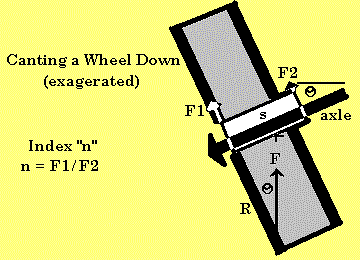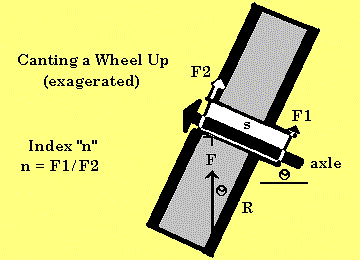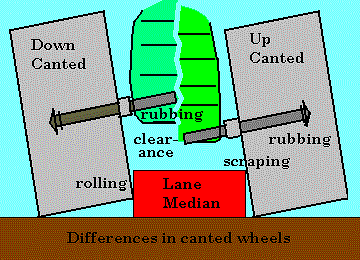
| Grand Prix Racing - | The Science of Fast Pinewood Cars |
One strategy to reduce the effects of isolated bumps on the track and reduce the effects of median collisions is to configure the wheels so they only touch the track on a narrow edge and touch the lane median with the other edge. The first goal can be achieved by cutting tread. But to do both at once, canting the wheels down is the best answer. Since it is also possible to cant wheels up and the models are very similar, that will be discussed here too.
When the wheels are canted at an angle by pushing the axle up or down, they no longer rest squarely on the axle. The force from the edge of the tire on the track pushes the wheel bore into the car body (down) or the axle hub (up). Friction in the area of contact is increased. But because some of the friction is shifted off the axle, the axle friction is decreased. Additionally, in the case of down canted wheels, the median friction can be reduced. The following model derives some effects of canting wheels, attempting to provide evidence to help determine if this is a good practice.

| F | Force on edge of wheel on track |
| F1 | Force on bore at wheel face |
| F2 | Force on bore at wheel hub |
| Fa | Force up along the axle |
| R | Outer wheel radius minus inner wheel radius |
| s | Bore shaft length |
| O | 'Theta', angle the wheel forms with the track |
| n > 0 | An index indicating F1 is n times stronger than F2 |
Important expressions derived for this model include:
| Stasis | F1RtanO - F2(s-RtanO) = 0 and FcosO = F1 + F2 |
| Fa | Fa = FsinO |
| Force Ratio | F1 = nF2 |
| F1 | F1 = FcosOn/(n+1) |
| F2 | F2 = FcosO/(n+1) |
| O | O = arctan(s/(n+1)R) |
This model begins as do many others by writing the equations of motion as simply as possible. In this case, a torque develops about a point on the axle near the center of the axle bore. If the wheel bore remains in full contact with the axle, there is no net rotation. Assume the wheel bore touches the axle only at its extreme ends. This will help us understand the forces better. We do the canted down wheel first.
When the wheel is not changing its angle to the axle (no net rotation) we can write:
F1RtanO - F2(s-RtanO) = 0
Which is a relationship between the two forces F1 and F2
F1RtanO = F2(s-RtanO)
To show how they are related more explicitly, we take the ratio of F1 to F2
F1/F2 = (s-RtanO)/RtanO
Simplify
F1/F2 = s/RtanO - 1
Now define an index, n, to make it easier to interpret this relationship since we won't be measuring F1 and F2 directly.
Let n = s/RtanO - 1 for any number (including fractions) since it can be greater or less than 1 depending on s, R and O.
Then we can substitute this index, n, for F1/F2 and get a mental picture of how various model parameters change with it. For example, solve for theta, O, the canting angle of the wheel in the expression for n.
O = arctan(s/R(n+1))
Now, let's see what F2 looks like in terms of this n. The part of the force in the direction along the wheel face at the edge of the wheel where it touches the track must be
FcosO = F1 + F2
Substituting F1 = nF2
FcosO = nF2 + F2
Simplify and swap sides
F2(n+1) = FcosO
Divide through to isolate F2 (to a point)
F2 = FcosO/(n+1)
If we look at the torque about the wheel bore at its face then we see that
F2 = FRsinO/s
So we can equate the two expressions for F2 and see what n+1 is
F2 = FRsinO/s = FcosO/(n+1)
Divide out F
RsinO/s = cosO/(n+1)
Isolate n
n+1 = scosO/RsinO
Simplify by knowing sinO/cosO = tanO
n = s/RtanO-1
It's the same as above, so we're on the right track.
What is F1 in terms of n? This time substitute F2 = F1/n
FcosO = F1 + F1/n
Simplify and swap sides
F1(1+1/n) = FcosO
Normalize the term in parentheses so the n can be divided out
F1(n+1)/n = FcosO
Now multiply and divide through to isolate F1
F1 = FcosOn/(n+1)
To get the force up along the axle, we just need a bit of trigonometry to notice that the force splits along the axle and wheel face at right angles. So the part of the force along the axle, Fa, is
Fa = FsinO

Canting a wheel up creates a very similar situation as canting down, except the force on the inside edge of the wheel bore acts like the wheel face force, F1, in the downward canting case and the wheel bore facing edge acts like F2 did. Because of this, the geometry of the situation is changed a bit. The little extended piece of the wheel bore has to be accounted for in the lever arm of F1, not F2. Because it is not flush with the face, a little offset, o, must be introduced that makes the resulting equilibrium equation difficult to work with. Here it is:
F2(s-RtanO-o) = F1(RtanO+o)
Forming F1 over F2 we get
F1/F2 = (s-RtanO-o)/(RtanO+o)
We will make this the index, n, for upward canted wheels
The expression for the canting angle, O, (after substituting n = F1/F2) is
O = arctan(s/R(n+1)-o/R)
Using this new index, n, the rest of the analysis above for downward canted wheels remains the same (to check use F(s-RtanO-o)cosO = F1s). But even if they didn't, we can always let the offset, o, become zero and force the two models to be the same. At least we would know for sure they are the same in that limit. Fortunately, they turn out to act the same despite the offset.
But acting the same doesn't mean the critical values of the angles are the same. If a canted wheel is tipped too much, the wheel torques on the axle and the axle friction begins to increase. The up canted wheel reaches this angle at a lower value than the down canted wheel because of the offset, o. Said differently,
|

When considering canting wheels up, note that they have some unique problems. One is that of rubbing the lane median across its top edge. If the lane median is rough on top (and most seem to be) then scraping its edge will catch all the little splinters on it. A second problem is that the wheel hubs may hit the lane median since they are brought lower to the track by canting. Though this is not good, it is better than the first problem because a break at the hub is less effective than one of the same force at the tread. A third problem is that the whole bottom of the car is lower and may srape the lane median if enough clearance is not left.
First, let's see what we can figure out about the size of the forces F1 and F2 compared to F for AWANA kit wheels. Both expressions for F1 and F2 have the factor FcosO. The cosine will have a size or magnitude of one or less, so FcosO will be equal to F or less. Both are divided by n+1. That means the FcosO value is split up into n+1 pieces, F2 gets one of them and F1 gets n of them because that's the other factor in the expression for F1. It seems F1 is n times the size of F2.
In fact, F1 is n times the size of F2 if n is greater than 1. But when n is less than 1, 1/n is greater than 1, so F2 is greater than F1. When n = 1, the canting angle is:
Downward canted, O = arctan(s/(n+1)R) = arctan(s/(1+1)R) = arctan(s/2R) = 15.0 degrees.
Upward canted, O = arctan(s/2R-o/R) = 5.6 degrees.
When a downward wheel is canted more than 15 degrees and an upward one more than 5.6 degrees, n is less than 1 and when they are canted less, n is greater than one.
The effect on total friction can be determined by writing the friction for a squared up wheel and subtracting it from the expression for a canted wheel. Here we do not account for the median friction which is a "random" event if wheel alignment is good. For a squared up wheel we have:
Squared up wheel friction = nF(1-sinO)r/R + nFsinOr/R+ u(F+w)
The axle friction term is split to include a term (the sinO term) that appears in the total friction of the canted wheel shown next.
Canted wheel friction = nFcosOr/R + v(F+w) + hFsinO
where h is the hub or body friction coefficient, which ever applies for canting the wheel up or down. v is the tread friction coefficient since it is expected to be a bit less than u on a bumpy track.
The difference, D, is
D = nF(1-sinO)r/R + nFsinOr/R + u(F+w) - (nFcosOr/R + v(F+w) + hFsinO)
Simplify to
D = nF(1-sinO-cosO)r/R + FsinO(nr/R-h) + (F+w)(u-v)
For small angles, sinO+cosO is essentially 1, so the first difference term vanishes.
The second term, FsinO(nr/R-h), says that if h is less than nr/R, then the friction will be less. That is, if h < nr/R which is about n/10. So h has to be less than a tenth of the axle friction coefficient. That's not likely going to happen.
The third term says that if the canted tread friction coefficient, v, is less than the squared up tread friction coefficient, u, that will help reduce the friction.
To see how much less v has to be than u when D is positive, we solve the difference expression, D, for v.
v = u -(D-FsinO(nr/R-h))/(F+w)
Setting D to 0 shows us just how much less v has to be than u. Call this amount "e".
e = -FsinO(nr/R-h)/(F+w)
Since h is likely the size of n or more, e will be a positive value as expected.
Evaluating for one reasonable set of parameters where we assume h = n, gives
e = -(5/4)sinO(-9n/10)/(11/8) = 9nsinO/11 = 9nO/11 using a small angle approximation where O is measured in radians.
For n = 0.1 and O = 10 degrees = 0.17 radians, e = 9*0.1*0.17/11 = 0.014
This looks like an achievable amount of reduction in tread friction coefficient. It amounts to about ten percent of the tread friction coefficients I've measured.
For down canted wheels, we must also consider the likely reduction in friction with the lane median since the wheel basically rolls (instead of rubbing) against the median when it gets too close. The reduction in median friction will be most noted in cars that are poorly aligned and spend significant time rubbing their inner wheel edges on the median. This is a difficult situation to factor in to the decision to cant or not to cant because we always hope our cars will be aligned well. Perhaps you can make this jugdment call based on your past ability to align your cars.
|
Using your own measurements in these equations can help you determine how much your tread friction would need to be reduced.
| [Pit Area] | [Title Page] |
| Grand Prix Racing - | The Science of Fast Pinewood Cars |
| Copyright © 1997, 2004 by Michael Lastufka, All rights reserved worldwide. | |